Kraków 2011-09-09
Iliuszyn Ił-2 Shturmovik (Штурмови́к)
English version
History

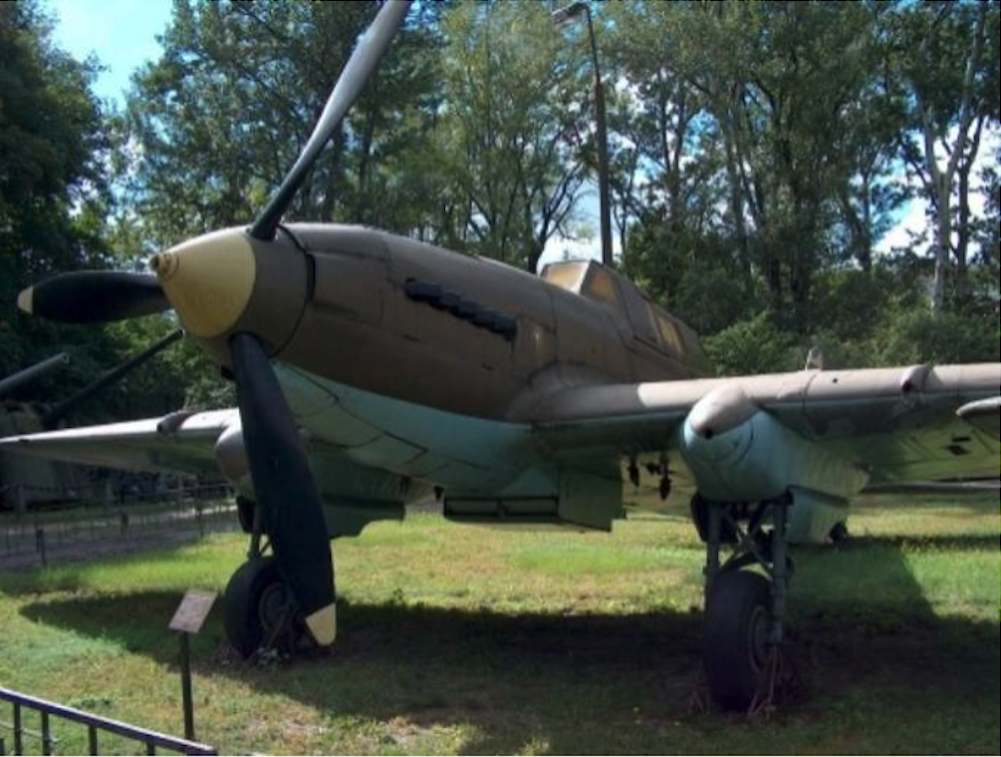
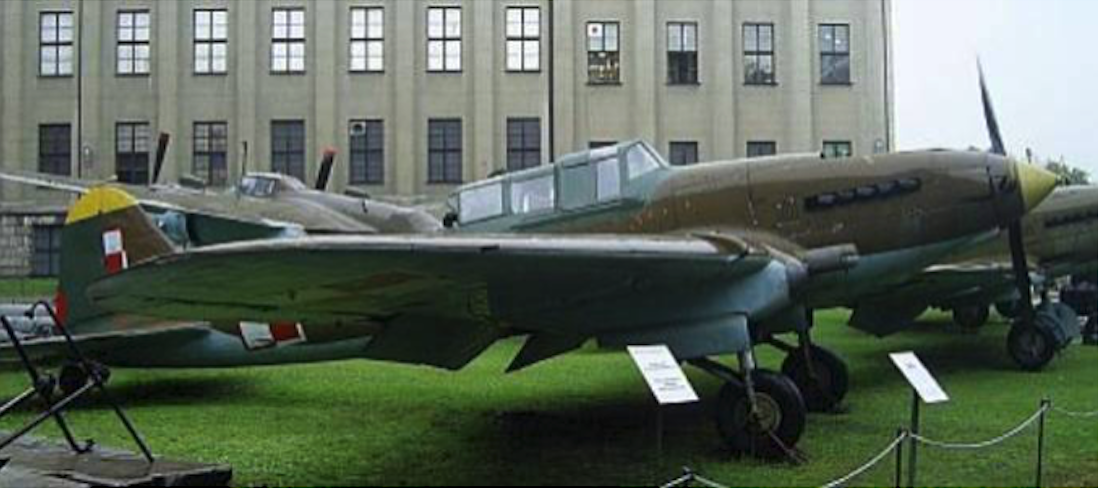
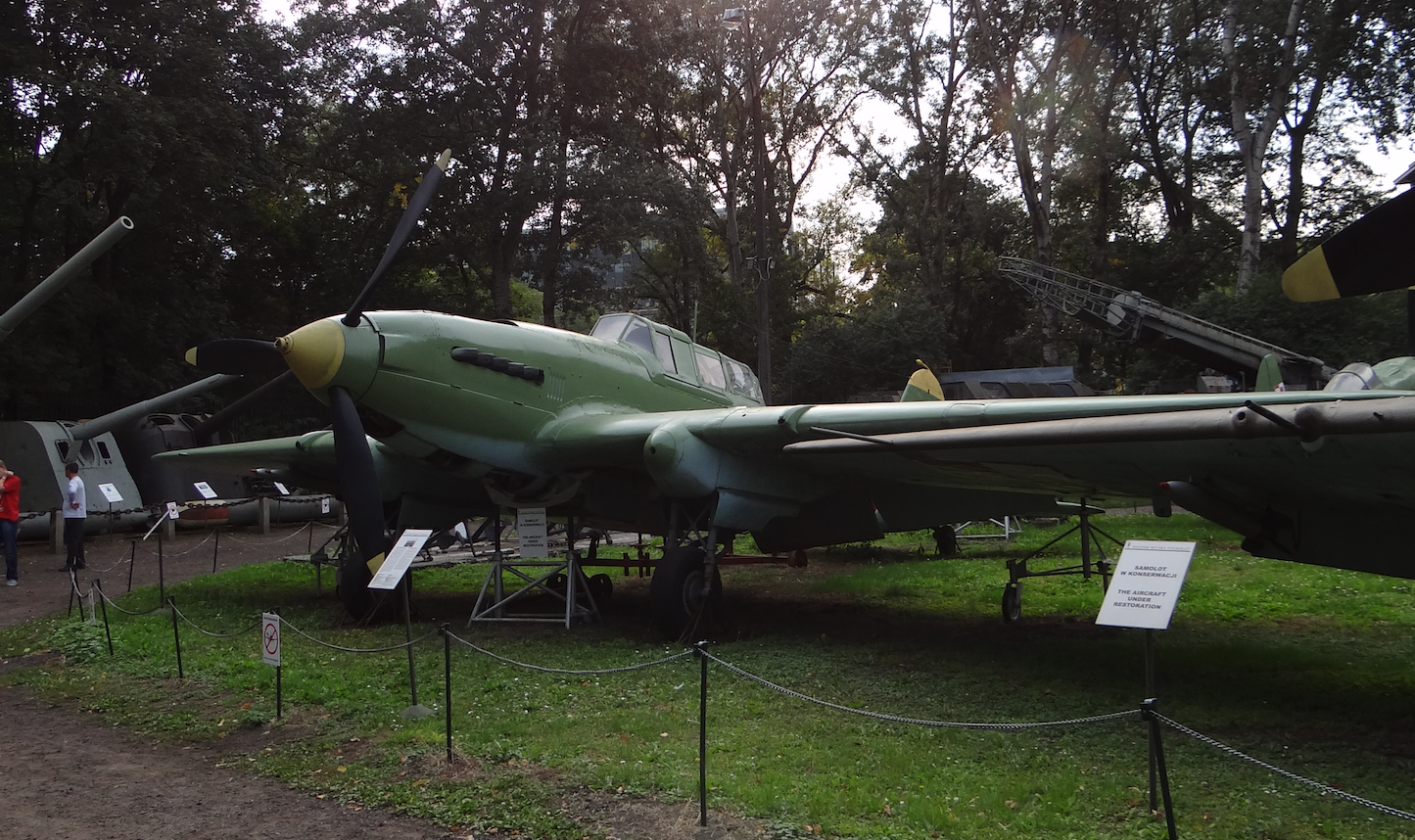

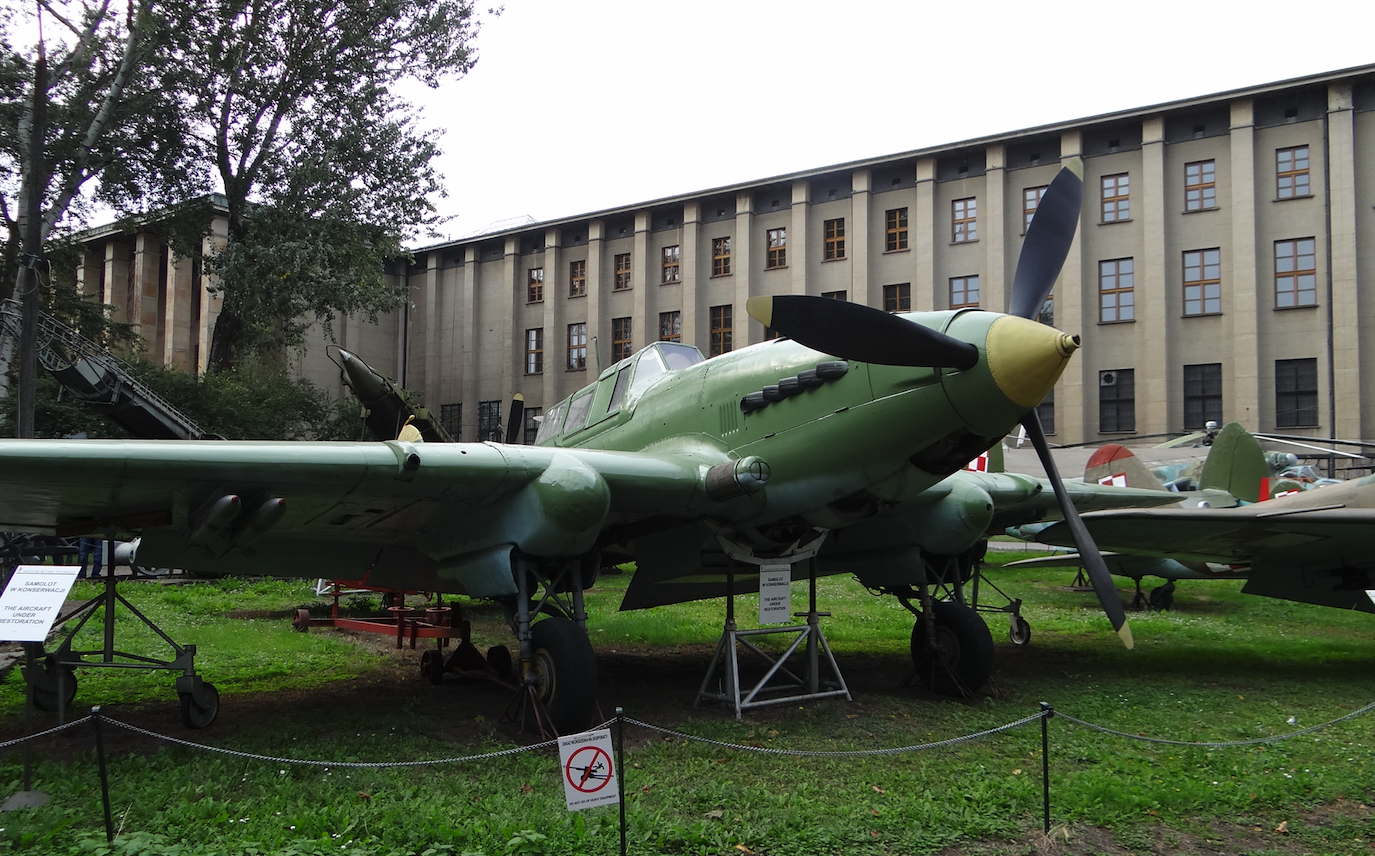
History
The Ił-2 plane is the best Soviet aircraft construction of the Second World War. Many people consider this aircraft the best the Second World War ground-attack. The Ił-2 plane was developed by Sergei Iliuszyn. These aircraft were built in the copies of 36,183, making it the most-produced combat aircraft.
The very good relations between Sergey Ilyushin and dictator Stalin have contributed to the success of the Ił-2 aircraft. Siergiej Iliuszyn was the most dictator's favorite engineer. He was never, like others, ever accused of betraying "the ideals of communism." If any of the factories producing these planes recorded a drop in the production rate, Stalin sent a warning to the factory manager - "These airplanes are needed by the Red Army, like air and bread."
Sergey Iliuszyn started working on the plane in 1938. The aircraft was designed with a double crew. But at the order of Stalin, a single-seat variety was created. The argument was - the plane was supposed to destroy ground targets, so why would the shooter shoot him backwards? As a result, during the fraternal war (Germanic - Soviet) in 1941, the Red Army suffered large losses.
The first project, designated as CKB-55, was a two-seater. The 700-kilogram armor protects the crew, an engine, a water cooler, an oil cooler and a fuel tank. The maximum take-off weight of the machine was over 4,700 kg.
The prototype of the Ił-2 aircraft, designated as CKB-55 at that time, made the first flight on October 2, 1939, by General pilot Vladimir Kokkinaki.
The CKB-55 aircraft competed with the design of Paweł Suchoj, a Su-6 stormtrooper, on a plane for the Red Army. Siergiej Iliuszyna's plane won and received the BSz-2 (combat stormtrooper) mark. However, the BSz-2 had a weak engine (Mikulin AM-35 with a capacity of 1 022 kW, 1 370 hp), for such a large mass of the machine. The performance was satisfactory only at high altitudes. S. Iliuszyn knew about it, and for this he proceeded without any protests to develop the single-seat version, designated as CKB-57. In place of the second cabin an armored plate and an additional fuel tank were inserted. The machine also received an AM-38 engine with better performance at lower ceilings.
The CKB-57 prototype made its first flight on October 12, 1940. State tests were carried out in March 1941, and after them in April 1941, the plane was officially marked the Ił-2. The prototypes were built at plant No. 39 in Moscow, at which the office of S. Iliuszyna was located. There, serial production was also launched. The first machines for military units arrived in May 1941.
In 1942, an AM-38 F engines were missing, because the factories of these engines were just evacuated into the CCCP. The ASz-82 engines were attempted to be mounted on the Ił-2 planes. But these engines were needed for the Ła-5 fighters.
Large losses of single-seater the Ił-2 caused that the army demanded return to the machines with the rear gunner. This was achieved at the end of 1942. The rear gunner had only armor from the floor. Full protection of the rear gunner appeared in the next aircraft Ił-10 (1944). The aircraft took less weapons, 400 kg, instead of 600 kg. The two-seater Il-2 entered the battle on October 30, 1942, at Stalingrad. Apparently, a part of single-seated machines was rebuilt to a two-seater version. This information is unlikely due to the shortage of aircraft on the war front
The Ił-2 was produced: in Moscow in Factory No. 39, 30, in Kuibyshev in Factory No. 1, 18, in Leningrad in Factory No. 381. By 1945, 36,183 were built. Such a large production and construction in various factories caused that the planes differed significantly. With time, the metal tail was replaced with wooden. Extra reinforcements were given up. A lighter armor was mounted on planes. Et cetera.
Various tests with engines, with weapons and others components have been carried out all the time. Airplanes were built in short series. Almost all were tested in battle at the front. The resulting versions: school, torpedo, hunting, reconnaissance and correcting artillery fire (with long-range radio and photo camera).
The most popular was the Ił-2 m 3 variant and with the AM-38 engine with the power of 1 700 HP. Armament; 2 x 23 mm caliber (2 x 210 rounds), 2 km 7.62 mm caliber (2 x 750 rounds), 1 km rear gunner caliber 12.7 mm (150 rounds), 400 kg bombs, sometimes 4 n.p.r (rocket – missile) RS-82 or RS-132. A self-sealing fuel tank was used. Duralumin wings, which changed the angle of wedging in relation to the fuselage. The control system has been improved.
Combat use of Ił-2 aircraft
When in June 22, 1941, the Germans attacked the CCCP, the Red Army had only 249 Ił-2 (single-seater). Their pilots were inadequate. Science limited itself to takeoffs and landings. During the training, no weapons were used. Tactics of using these new combat machines have not been developed.
The first combat use of the Ił-2 aircraft took place on the Berezina River, where the 4th Air Assault Regiment tried to stop the German attack. The first clashes ended in total failure. During the first three days, the regiment lost 10 machines, and another 19 destroyed the undernourished pilots. For 20 days of war, a regiment of 65 machines remained with 10 aircraft. In general, in 1941, it was the most tragic period of the Ił-2 use. Airplanes were shot almost massively. In the course of three days of October 1941, the 280th Air Assault Regiment lost 11 machines. In turn on another day, with 5 machines, three aircrafts did not return to the airport. According to official statistics from 1 500 machines delivered by December 31, 1941; 1,100 aircraft were lost and 600-800 pilots were lost.
New tactics of aircraft use were developed in the battle. Though, for example RS-82 or RS-132 (rocket – missile) easily destroyed every tank completely, then it was a great luck to hit it. Therefore, pilots preferred to use the machine guns. The first short series pointed to the arrangement of the missiles, then the correction of the sight and the second series of bullets were in sight. However, with time the parcels were getting worse and worse, which translated into accuracy. From 100 percent of the projectiles fired, only a few percent reached the target. A massive attack for one purpose was used. About 4-12 machines. The attack was carried out in a circle to keep the target at all times. Flat bombardment was replaced by light diving. About 10 degrees. Thanks to this, a series of the machine guns, and then an antitank bomb amendment. There were also cluster bombs. 4 cluster bombs are a total of 192 small-scale bombs. The FAB-100 bombs were also effective. But the fragments of this bomb often damaged the attacking aircraft. That is why time fuses were introduced. A capsule with white phosphorus was also used, but the effect of phosphorus depended on humidity, temperature and wind.
Until the end of the war for Ił-2, a good sight of small arms and bombs was not developed. Most pilots have developed their own methods. The bomb hit an object with an area of 2,000 m2 from a height of 50 m - 200 m with a probability of only 3 percent.
The breakthrough in the use of the Ił-2 occurred after the introduction of the two-seater version, and the tactical return was the fight at Kursk (July 1943). On July 7, 1934, Il-2 destroyed 70 tanks in 20 minutes. It was then that the Germans called Ił-2; black death, butcher, meat machine, iron taste.
The Ił-2 destroyed, without any problems; railway stations, bridges, airports, factories, but the attacks on the OPL position almost always ended in failure. A 20 mm or 37mm OPL cannons were very good and effectively destroyed the Ił-2. That's why the Ił-2 suffered such losses. The Ił-2 assault was not afraid of the 88 mm OPL cannons, because they were too slow for fast and low flying aircraft. The 88 mm cannons was effective against bombers. As a further consequence, it was more a result of the decrease in the morale of the Germans than the increase in the effectiveness of the Ił-2. The armor was effective only against manual machine guns.
In the two-seater Ił-2 aircrafts, the rear gunner had a tragic position. His position was poorly protected. Often, the rear gunner was killed by debris. Seven shooters were killed on one killed pilot (!).
Until the end of the war, each Soviet regiment used its own tactics of combat with the Ił-2 aircraft. Pilots, if they did not make flights, they talked about their flights, opponent, plane and its weapons for hours. That's how their experience grew. They did not have support from the command, and the only changes were sending new planes and even younger pilots. Appropriate regulations, guidelines and regulations have never been developed. Stalin's tactics consisted of the principle - the power of evil, for one. In CCCP soviet man was not to be value (as always in Moscow).
In principle, the Ił-2 was a good and necessary construction, but without serious disadvantages. The basic should include poor performance and low-quality materials used. Airplanes were built for quantity, not for quality. Lack of any radio stations ruined every tactical assumption. Low-quality firearms were used. The shooting sights were poor, and there was no bomb sniper at all. The pilots were badly trained. If they were better trained, many losses could be avoided. Women were also pilots. The training of not only pilots but also mechanics was poor, and as a result, the service was not correct and contributed to unnecessary failures. Not fully retractable chassis was vulnerable to damage. That is why they often landed without the chassis extended, which damaged the radiator.
The Soviets lost 10 762 the Ił-2 aircraft in combat. One aircraft was lost on 11 flights (not only combat).
However, the fact is that the plane was designed for the Second World War assumptions. Where attack aircraft were to fly under hunting cover. The war in the East verified this view negatively.
Another fact is that the improper configuration of the airframe and power unit has never been abandoned. The use of two engines was beyond purpose. And so with one engine inoperative, the plane was cut out of combat. One engine is also a large armored cover for the crew. On the other hand, flights with only 400 kg of bombs are the effect of a low power drive unit. But all planes of Second World War suffered from this problem.
Ił-2 in the Polish Aviation
For the date of the introduction of the Ił-2 aircraft to the Polish Army, we adopted the date 30 August 1944. Why? Because on this day an order was issued that subordinated the 611st Soviet Assault Regiment under the Polish Army created in the East. It was a regiment that used the assault Il-2.
In August 1944, the Polish Army was established, in the East, the 611st Soviet Assault Aviation Regiment. It became a part of the 1st Polish Air Division. The 611st Aviation Assault Regiment was formed according to the No. 015/282 post-war order, with 199 persons. At the end of August 1944, he was excluded from the structures of the Red Army and subordinated to the 1st Army of the Polish Army. Officially, this was by virtue of General Order No. 0211 of the Commander of the 1st Polish Army of August 28, 1944, on the inclusion of newcomers.
The regiment had a long combat trail behind it and used already heavily exploited famous the Ił-2 aircraft. It personal composition was one hundred percent Soviet. Already on August 30, 1944, the regiment was subordinated to the commander of the 1st Air Division, Colonel Józef Smaga. This was due to the command of the commander of the 1st Polish Army No. 0213 of August 30, 1944, "on the temporary organization of the 1st Air Division Command."
On August 31, 1944, the 1st Air Division was renamed the 4th Mixed Aviation Division, and the 611st Aviation Assault Regiment was renamed the 3rd Air Force Regiment. This was done under Order No. 91 of the Supreme Commander of the Polish Army of August 31, 1944, "on the organization of unions and air units". In this way, three regiments, on August 31, 1944; 1 PLM "Warsaw", 2 PNB "Krakow", 3rd Air Assault Regiment, formed the 4th Pomeranian Mixed Air Division.
The Ił-2 aircrafts in the colors of Polish Aviation (but mainly with Soviet crews) took part in battles in the area; Warki, Wał Pomorski, Kołobrzeg. These machines also took part in the battles with the German Steiner Group in April 1945.
But that's not the end. In the CCCP, in the village of Biełyj Kołodiec near Wołczańska, where on October 12, 1944, on the basis of the 658th Soviet Assault Aviation Regiment, was formed 6th Assault Aviation Regiment, which was officially part of the 2nd Assault Aviation Division. The first commander of the Regiment was Colonel Edward Wiik (of Estonian origin). Because the Regiment had a long war trail behind it, he had to succumb to the reformed. In the period from October 1944 to January 1945, the regiment completed the personal status of Polish citizens. Aircafts were repaired and new machines were obtained from Soviet factories. New pilots and shooters were trained on the UIł-2 (training) and the Ił-2 m 3.
Until December 1944, the 1st Mixed Aviation Corps was formed. It consisted of three regiments, including 3rd PLSz, equipped with the Ił-2 m 3 aircrafts. Subsequently, two Assault Aviation Divisions were established, which were subordinated to 6th, 7th and 8th PLSz.
In March 1945, the 6th Regiment Assault Aviation began to be ferrying to Poland. The Soviets were very careful not to let the Polish Soldier fight in the former Polish Borderlands. The screening was completed on April 12, 1945. The Ujazd airport near Tomaszów Mazowiecki became the base. Here, the first solemn military oath was organized. In April 1945, there were 30 aircrafts in the state of the regiment: Ił-2, Uił-2, Po-2.
On April 23, 1945, the regiment was transferred to the Kruszwin airport. The regiment at that time was commanded by Major Kapustin (soviet). On April 25, 1945, regiment performed the first combat mission as part of the Berlin operation. The task of the stormtroopers was to bomb the Bergsdorf railway station, under the cover of fighters also from the Polish 9th Fighter Regiment. 7 railway cars and 10 cars were destroyed. Germanic artillery damaged one Ił-2 aircraft.
Already on April 27, 1945, the regiment was moved to the Barnówko airport, and then Grunsthal.
In the period from April 27, 1945, to April 30, 1945, the crew of the regiment carried out 26 combat flights, destroying: 10 tanks, 30 cars, 10 trailers.
On May 1, 1945, the regiment destroyed during the combat operations near Lentzke and Fehrbllin; 4 tanks, 50 cars, ammunition storage.
On May 3, 1945, the regiment completed combat operations.
War balance of the 6th Aviation Assault Regiment; 134 combat flights, destroyed; 14 tanks, 135 cars, 40 trailers, 19 wagons, 15 artillery guns, 23 anti-aircraft guns, 60 horse carts, 6 ammo and ammo warehouses. The regiment did not lose any aircraft.
Post-war time
At the end of Second World War, all Polish regiments are ordered to return to Poland. The 2nd Aviation Assault Division (6th, 7th, 8th PLSz) was ferrysed to the so-called Łódź airport node (Lublinek and Ujazd airports). Three PLSz were sent to Bydgoszcz. On May 10, 1945, 3rd PLSz together with 2nd GNP "Kraków" began operations at the Bydgoszcz airport. At that time, the airport is operated by the 73th Battalion of the Airport Service. Many regiments are being dismantled, but the 6th Regiment remains. The divisions are dissolved and the regiments are under the direct command of the Air Forces. However, this situation does not last long.
At the end of the war, the Polish assault aviation had four assault regiments, in which the basic plane was the Ił-2, mainly in the Ił-2 m 3 version. The Ił-2 aircrafts were 142-158 copies, which constituted about 35 percent of all combat machines. In addition, regiment had 15-19 UIł-2 school airplanes.
Already at the turn of 1945/1946. the 2nd Air Force Strat Division and its two regiments were disassembled; 7th and 8th PLSz. In turn, 2nd PNB Kraków were renamed to 2nd PLSz, and then to 4th PLSz.
On January 24, 1946, the Order of the Supreme Commander of the Polish Army appeared. By virtue of this order, the 2nd Division Assault Aviation is formed with the depot;
-
4 PLSz - previously 2 GNP "Kraków".
-
5 PLSz - previously 3 PLSz. Regiment involved in Second World War
-
6 PLSz - regiment taking part in Second World War
-
7 PBN (Regiment Bombers) in Łęczyca
Numbers 1st, 2nd, 3rd, went to the Fighter Aviation Regiments. The aim was to create three fighter regiments, three assault regiment and one bombing regiment. A new structure and command system for a fully sovereign country was to be created. All these changes took place under Order No. 019 / Org of the Supreme Commander of the Polish Army of January 22, 1946 and Command No. 08 of the Commander of the Polish Armed Forces of January 24, 1946.
4th PLSz and 5th PLSz operate jointly from the Bydgoszcz airport. For the duration of the general reconstruction of the Bydgoszcz airport, both regiments were moved to Lublinek airport in Ruda Pabianicka.
However, the second half of the 40's is a very difficult period for the Polish Nation. We are under increasingly stronger Soviet domination. Many of our countrymen can not return to the country, and those who have returned are persecuted, often imprisoned and often sentenced to death for alleged espionage. This fate does not bypass Polish aviators fighting in the West. The Soviet officer is in the Polish command, and the communists with Polish pedigree equalize them. There were also purges. Anyway, this is a topic for a separate chapter.
When it comes to flying equipment, the situation looked bad. Machines that participated in the war were still used. The new aircrafts appeared only in February 1949, in the form of non-modern structures of type the Ił-10 and its Czechoslovak license the B-33. What's worse, it was not a view of modern equipment, because our new "supervisor" did not carry out any work on a modern assault aircraft.
Although after 1945, we had three regiments of assault aviation, they differed from each other diametrically. 4th and 5th PLSz went through a transformation period. 4th PLSz was training from the Po-2 planes at the Ił-2. 5th PLSz was transformed organizationally, because until the end of the war all its pilots were soviets. So they also had to train Poles.
The situation was different in 6th PLSz. In its most of the soldiers from the very beginning was Polish nationality. The regiment was built in the depths of the Soviet empire. The soldiers took an active part in the final activities of Second World War. That is why the regiment received other tasks.
In April 1947, a decision was made to combat the use of the Regiment in battles in the Bieszczady Mountains. In the period from May 1947 to July 1947, four aircrafts from 6th PLSz supported the operations of the Operational Group "Wisła". The Ił-2 aircrafts was commanded by pil. Kazimierz Czubkowski. Airplanes operated from the Jesionka airport near Rzeszów.
In July 1947, the regiment was transferred at the Wrocław-Strachowice airport. Then at the Piła airport. The condition of flying equipment in 6th PLSz on 1 September 1949: 38 Ił-2 m 3, 7 UIł-2, 12 Il-10, 7 Po-2.
At the end of 1947: 4th, 5th, 6th PLSz were based in city Bydgoszcz and city Wrocław. The assault planes from the Ił-2 war production still had equipment.
In 1947, the Ił-2 aircrafts were also in the state of the Officers Aviation School in Dęblin, and from the beginning of 1948, they came to the Independent Navy Squadron.
At the end of 1948, there were 138 the Ił-2 aircrafts and 32 the UIł-2 aircraft trainers on the Polish Army.
The decisive withdrawal of the Ił-2 aircrafts from Polish regiments took place with the delivery of the first the Ił-10 aircrafts. The Ił-2 aircrafts disappeared completely in 1951.
The Ił-2 aircraft in Poland did not stand on monuments. Nobody mentions its with sentiment. And good, because it reminded the Polish nation of the introduction of communism. In Poland, only one museum copy remained, which is in the Museum of the Polish Army in Warsaw.
In the period 1944-1946. Polskie Wojska Lotnicze (Polish Air Force) received about 250 the Ił-2 aircrafts, which were in use until 1949-1951.
Computer life the Ił-2 aircraft
With the introduction of common PCs, a whole bunch of games and flight simulators of various combat machines appeared. The Ił-2 was the first place from the machines taking part in Second World War. About hundred of computer programs have been created, in which the Ił-2 is a hero. In this way the Ił-2 gained a second, this time virtual, life. Until now (2011) the Internet is full of simulators, games, discussion forums, descriptions and assessments of this aircraft. The fact that there was no later worthy successor of this type of combat machine contributed to popularization.
Written by Karol Placha Hetman
Kraków 2011-09-09
Iliuszyn Ił-2 Shturmovik (Штурмови́к)
English version
Construction
The Ił-2 is a typical ground-attack aircraft. Single-engine, self-supporting low-wing, mixed construction. Good armed and armored. There were single-seat and two-seat varieties. In the two-seat variant, the second crewman was the rear shooter. In the Polish Army, single-seat variety was not used.
The wings are technologically divided into three parts; center wing and two attached wings. The center wing in the interior had a bomb chamber. The outermost ends of the center wing had main landing gear chambers and a mechanism for its concealment.
The fuselage is technologically divided into two parts. The front engine began with the fuel tank and crew cabin behind. The critical elements of the machine were armored. Among them; engine, fuel tank, pilot cabin, oil coolers and engine coolant. The armor is made of thick steel plates, joined by rivets or screws. The rear part of the fuselage was classic, made of metal or metal and wood. Classic shutdown, divided into ballasts and rudders. Made of metal or mixed construction.
Three-support chassis with rear support. Main landing gear supported and hidden in the wings, towards the rear. Each main chassis was equipped with one wheel on two shins. After hiding the chassis, the wheel partially protruded from the contour of the wing. The tail wheel was permanently mounted.
Equipment
The aircraft's equipment was less than modest. There was no bomber sight, only a simple shooting sight. There was no radio station. Only a few planes of key or squadron commanders had them. It was only after the war that all aircrafts were equipped with radio stations in Polish regiments. There was no fire protection installation. Aircrafts did not have any lighting, including anti-collision. Only some clocks on the pilot's instrument panel were highlighted. It was only later that the reflector was mounted in the leading edge of the left wing. The aircraft did not have throwaway chairs. The crew had parachute seats.
Drive
The AM-38 engine, piston, 12-cylinder V system with 60 degrees opening. Liquid-cooled. Depending on the version, it achieved power from 1,600 hp to 1,700 hp. The engine was designed by Aleksander Mikulin. The engine was made of poor quality raw materials and was highly stocked, so its lifetime rarely exceeded 150 hours of work.
Armament
The armament was strong side of the aircraft. Of course in the offensive system. Permanent weaponry. The basis was two machine guns. Initially, the type SzWAK kal 20 mm. Later, the plot WJa kal 23 mm. The armament were supplemented with two machine guns, the type SzKAS kal 7.62 mm. Everything was mounted in the wings.
Bombs were attached in the bomb chamber.
It was possible to hang up additional bombs or wings, under the wings. RS-82 or RS-132. It was also possible to suspend containers with 37 or 45 mm calibres. The two-seater version, in the rear station, has the machine gun, the type UBT km 12.7 mm.
Data T-T
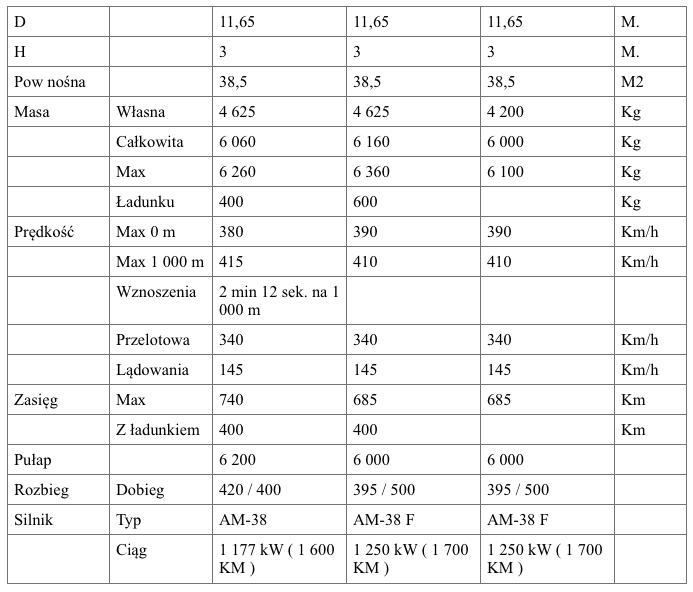
Written by Karol Placha Hetman
Kraków 2011-09-09
Iliuszyn Ił-2 Shturmovik (Штурмови́к)
English version
List
In Poland
According to the available data, from the moment of the end of Second World War on the state created in the CCCP of the Polish Army there were 142 to 158 aircraft. Mainly in the Ił-2 m 3 version. In addition, there were from 15 to 19 school machines marked the UIł-2. In the period from 1944 to 1946, Polish Air Force received about 250 aircraft of this type.
Detailed equipment for LWP (Polish Air Force) in the Ił-2 aircraft in May 1945
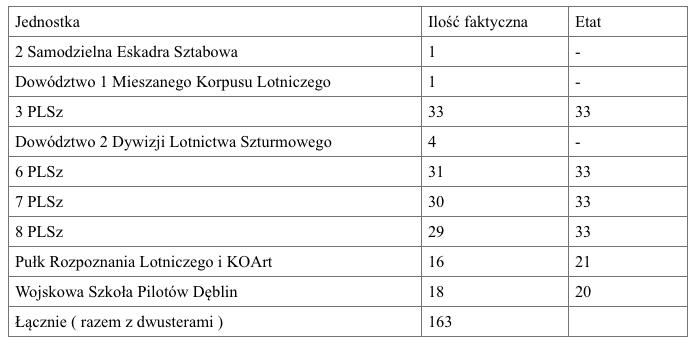
When in 1949 the withdrawal of the Ił-2 machines from the Polish regiments began, they had about 138 machines and 32 machines in the UIł-2 version.
Detailed equipment of LWP in Il-2 planes on November 1, 1949

Probably only one Ił-2 aircraft has survived and is presented in the Museum of the Polish Army in Warsaw.
Written by Karol Placha Hetman
